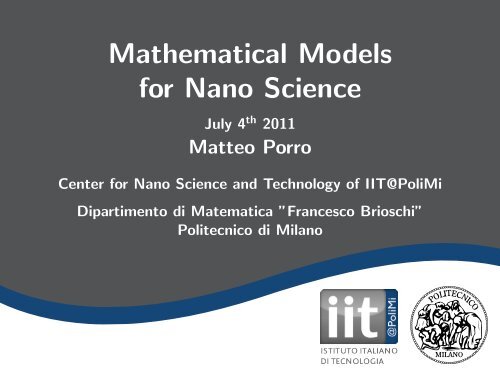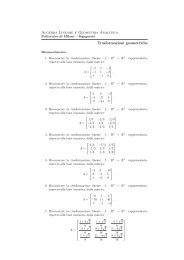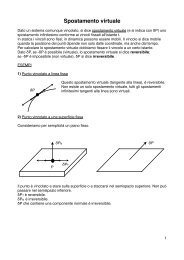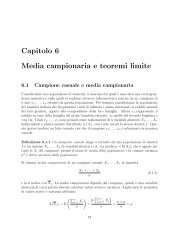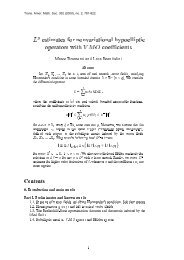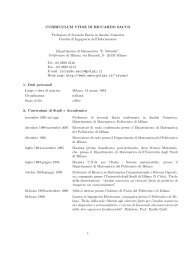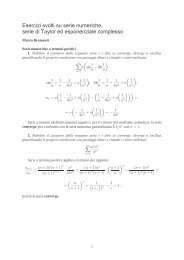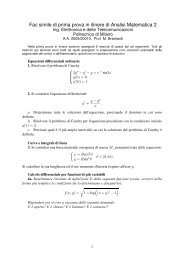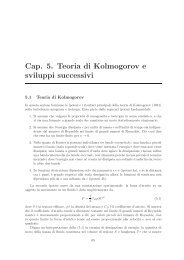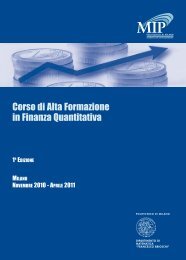Mathematical Models for Nano Science - Politecnico di Milano
Mathematical Models for Nano Science - Politecnico di Milano
Mathematical Models for Nano Science - Politecnico di Milano
You also want an ePaper? Increase the reach of your titles
YUMPU automatically turns print PDFs into web optimized ePapers that Google loves.
<strong>Mathematical</strong> <strong>Models</strong><br />
<strong>for</strong> <strong>Nano</strong> <strong>Science</strong><br />
July 4 th 2011<br />
Matteo Porro<br />
Center <strong>for</strong> <strong>Nano</strong> <strong>Science</strong> and Technology of IIT@PoliMi<br />
Dipartimento <strong>di</strong> Matematica ”Francesco Brioschi”<br />
<strong>Politecnico</strong> <strong>di</strong> <strong>Milano</strong>
Introducing myself<br />
Education<br />
• 2004 - 2008<br />
B.Sc. in <strong>Mathematical</strong> Engineering at <strong>Politecnico</strong> <strong>di</strong> <strong>Milano</strong><br />
thesis: Parametric analysis of the dynamics of a rowing boat<br />
• 2008 - 2010<br />
M.Sc. in <strong>Mathematical</strong> Engineering at <strong>Politecnico</strong> <strong>di</strong> <strong>Milano</strong><br />
thesis: Third generation solar cells: modeling and simulation<br />
Current position<br />
• 2011<br />
Fellow internship at CNST of IIT@PoliMi<br />
Future plans (???)<br />
• 2011 -<br />
Ph.D. in <strong>Mathematical</strong> <strong>Models</strong> and Methods in Material <strong>Science</strong><br />
at <strong>Politecnico</strong> <strong>di</strong> <strong>Milano</strong>
Math Research Group<br />
Prof. Riccardo Sacco<br />
• M.Sc. in Electronic Engineering and Ph.D. in Applied<br />
Mathematics<br />
Prof. Maurizio Verri<br />
• M.Sc. in Physics<br />
Carlo de Falco, Ph.D.<br />
• M.Sc. in Electronic Engineering and Ph.D. in Mathematics<br />
and Statistics <strong>for</strong> Computational <strong>Science</strong><br />
Marco Carnini, Ph.D.<br />
• M.Sc. in Physics and Ph.D. in <strong>Mathematical</strong> Engineering
Summary<br />
Past activity<br />
• Bulk heterojunction organic solar cell model<br />
• Bilayer organic solar cell model<br />
Present and future activity<br />
• SuperC model<br />
• Artificial retina model
Bulk Heterojunction solar cells<br />
light<br />
current<br />
at contacts<br />
absorbption<br />
ra<strong>di</strong>ative<br />
recombination<br />
drift / <strong>di</strong>ffusion<br />
bulk<br />
excitons<br />
<strong>di</strong>ffusion<br />
bulk<br />
free carriers<br />
interface<br />
excitons<br />
partial<br />
<strong>di</strong>ssociation<br />
geminate<br />
recombination pairs<br />
drift / <strong>di</strong>ffusion<br />
recombination<br />
interface<br />
free carriers<br />
recombination to<br />
triplet excitons<br />
<strong>di</strong>ssociation<br />
L<br />
Γ N<br />
Γ C<br />
hν<br />
Ω<br />
Γ A<br />
Γ N<br />
Assumptions<br />
• Homogeneity. Blend as a single material<br />
with averaged properties<br />
• Imme<strong>di</strong>ate transition exciton → charge<br />
transfer state<br />
• Einstein relation<br />
Unknowns: X , n, p and ϕ
Model equations - 1<br />
• Excited state<br />
equation<br />
{ ∂X<br />
∂t = G − k recX − k <strong>di</strong>ss X + γnp in Ω<br />
X (x, 0) = X 0 (x) in Ω.<br />
• No <strong>di</strong>ffusion → ODE → no need <strong>for</strong> boundary con<strong>di</strong>tions<br />
• Generation term G(x, t): constant, Beer-Lambert<br />
• Dissociation rate constant k <strong>di</strong>ss (E) accor<strong>di</strong>ng to Onsager theory<br />
• Langevin bimolecular recombination γnp<br />
• Electron<br />
equation<br />
⎧<br />
∂n<br />
∂t − 1 q <strong>di</strong>v J n = k <strong>di</strong>ss X − γnp in Ω<br />
⎪⎨<br />
J n = qD n ∇n − qµ n n∇ϕ in Ω<br />
1<br />
γ n<br />
q J n · ν = β n − α n n on Γ A ∪ Γ C<br />
⎪⎩<br />
n(x, 0) = n 0 (x) in Ω.<br />
• Drift-Diffusion model • Scott-Malliaras boundary con<strong>di</strong>tions<br />
• Simplified Poole-Frenkel model <strong>for</strong> mobility µ(E)
• Hole<br />
equation<br />
Model equations - 2<br />
⎧<br />
∂n<br />
∂t + 1 q <strong>di</strong>v J p = k <strong>di</strong>ss X − γnp in Ω<br />
⎪⎨<br />
J p = −qD p ∇p − qµ p p∇ϕ in Ω<br />
1<br />
−γ p<br />
q J p · ν = β p − α p p on Γ A ∪ Γ C<br />
⎪⎩<br />
p(x, 0) = p 0 (x) in Ω.<br />
• Similar to electron equation. Just some <strong>di</strong>fferences in the signs<br />
• Poisson<br />
equation<br />
⎧<br />
⎪⎨<br />
( )<br />
−<strong>di</strong>v ε 0 ε r ∇ϕ = q ( p − n ) in Ω<br />
ϕ = V appl − V bi<br />
⎪⎩<br />
ϕ = 0<br />
on Γ A<br />
on Γ C<br />
• Applied and bias potential → Dirichlet boundary con<strong>di</strong>tions<br />
• Electric field E = −∇ϕ
Numerical Approach<br />
Rothe method<br />
• Fully coupled system<br />
• Strongly nonlinear equations<br />
• Time <strong>di</strong>scretization with Runge-Kutta methods<br />
• Linearization of the problems<br />
• Spatial <strong>di</strong>scretization<br />
Functional iteration algorithms<br />
• Newton method: faster convergence but less robust.<br />
• Gummel map: staggered algorithm, (possibly) slower but<br />
robust. Also useful as a solution map <strong>for</strong> the analysis of<br />
existence/uniqueness.
Spatial <strong>di</strong>scretization<br />
Triangulation of the domain<br />
• Structured<br />
• Unstructured<br />
Methods<br />
• Finite <strong>di</strong>fference • Finite element • Finite volume<br />
Possibly arising problems<br />
• Instability/numerical oscillations<br />
• Flux conservation issues<br />
• Undesired negative values
1D examples<br />
Dominant transport<br />
{<br />
− 1 ε u′′ + u ′ = 1 x ∈ (0, 1)<br />
u(0) = 0, u(1) = 0<br />
• ε = 10 2<br />
Dominant reaction<br />
{<br />
− 1 ε u′′ + u = 1 x ∈ (0, 1)<br />
u(0) = 0, u(1) = 0<br />
• ε = 10 4<br />
1.6<br />
1.4<br />
1.2<br />
1<br />
Exact solution<br />
Numerical solution n=10<br />
Numerical solution n=20<br />
1.2<br />
1<br />
0.8<br />
u(x)<br />
0.8<br />
u(x)<br />
0.6<br />
0.6<br />
0.4<br />
0.2<br />
0<br />
0 0.2 0.4 0.6 0.8 1<br />
x<br />
0.4<br />
0.2<br />
0<br />
Exact solution<br />
Numerical solution n=10<br />
Numerical solution n=20<br />
0 0.2 0.4 0.6 0.8 1<br />
x<br />
• Many points <strong>for</strong> stability, even more in 2D or 3D<br />
• Solution: stabilization techniques and ad-hoc schemes
Numerical results - 1<br />
• Ideal BHJ solar cell<br />
• Short circuit con<strong>di</strong>tion (V appl = 0 V)<br />
• Same mobility <strong>for</strong> holes and electrons<br />
• Transient simulation in (0, 10 µs)<br />
• Low illumination<br />
G = 4.3 · 10 26 m −3 s −1<br />
• High illumination<br />
G = 4.3 · 10 30 m −3 s −1<br />
4 x 1019 Position [nm]<br />
2.5 x 1023 Position [nm]<br />
Electron density [m −3 ]<br />
3.5<br />
3<br />
2.5<br />
2<br />
1.5<br />
1<br />
0.5<br />
0<br />
0 10 20 30 40 50 60 70<br />
Electron density [m −3 ]<br />
2<br />
1.5<br />
1<br />
0.5<br />
0<br />
0 10 20 30 40 50 60 70<br />
C. de Falco & al. 2010
Numerical results - 2<br />
• Photodetector fabricated in DEI labs<br />
• BHJ of squaraine dyes and PCBM (ratio 1:3)<br />
• Thickness 220 nm, area 4 mm 2 , I = 6.3 Wm −2 , λ = 700 nm<br />
0<br />
x10 -7<br />
• With light<br />
measured data<br />
simulation results<br />
• Dark<br />
Current [A]<br />
-5<br />
-10<br />
-15<br />
0 0.1 0.2 0.3 0.4 0.5<br />
Applied bias [V]<br />
M. Binda & al. 2009<br />
C. de Falco & al. 2010
Bilayer solar cells<br />
light<br />
current<br />
at contacts<br />
absorbption<br />
ra<strong>di</strong>ative<br />
recombination<br />
drift / <strong>di</strong>ffusion<br />
bulk<br />
excitons<br />
<strong>di</strong>ffusion<br />
bulk<br />
free carriers<br />
interface<br />
excitons<br />
partial<br />
<strong>di</strong>ssociation<br />
geminate<br />
recombination pairs<br />
drift / <strong>di</strong>ffusion<br />
recombination<br />
interface<br />
free carriers<br />
recombination to<br />
triplet excitons<br />
<strong>di</strong>ssociation<br />
2H<br />
Ω n<br />
Γ C<br />
hν<br />
Ω H<br />
Γ N<br />
Assumptions<br />
• Depletion of electrons in Ω p and of<br />
holes in Ω n<br />
Ω p<br />
• Dissociation area Ω H<br />
• Einstein relation<br />
Γ A<br />
Unknowns: X , P, n, p and ϕ
Model equations - 1<br />
• Exciton<br />
equation<br />
⎧<br />
∂X<br />
∂t + <strong>di</strong>v J X = G − X τ X<br />
⎪⎨<br />
∂X<br />
∂t + <strong>di</strong>v J X = G − X −<br />
X + ηk rec P<br />
τ X τ <strong>di</strong>ss<br />
J X = −D X ∇X<br />
in Ω n ∪ Ω p<br />
in Ω H<br />
in Ω<br />
X = 0<br />
on Γ C ∪ Γ A<br />
⎪⎩<br />
X (x, 0) = X 0 (x) in Ω.<br />
• Excitons have null net charge → Only <strong>di</strong>ffusion (Fick law)<br />
• Generation term G(x, t): constant, Beer-Lambert<br />
• Exciton lifetime τ X , geminate pair <strong>for</strong>mation time τ <strong>di</strong>ss<br />
• Geminate pair recombination rate constant k rec and triplet<br />
exciton fraction η<br />
• X and J X are continuous in Ω
Model equations - 2<br />
• Geminate pair<br />
equation<br />
⎧<br />
∂P<br />
⎪⎨ ∂t = X − (k <strong>di</strong>ss + k rec )P + γnp in Ω H<br />
τ <strong>di</strong>ss<br />
P = 0<br />
in Ω n ∪ Ω p<br />
⎪⎩<br />
P(x, 0) = P 0 (x) in Ω.<br />
• No <strong>di</strong>ffusion → ODE → no need <strong>for</strong> boundary con<strong>di</strong>tions<br />
• Mo<strong>di</strong>fied <strong>di</strong>ssociation rate constant k <strong>di</strong>ss (E)<br />
• Langevin bimolecular recombination γnp<br />
• Electron<br />
equation<br />
(Hole equation<br />
is analogous)<br />
⎧<br />
∂n<br />
∂t − 1 q <strong>di</strong>v J n = 0<br />
∂n<br />
⎪⎨ ∂t − 1 q <strong>di</strong>v J n = k <strong>di</strong>ss P − γnp<br />
J n = qD n ∇n − qµ n n∇ϕ<br />
n = 0<br />
in Ω n<br />
in Ω H<br />
in Ω n ∪ Ω H<br />
in Ω p<br />
n = n C<br />
on Γ C<br />
⎪⎩<br />
n(x, 0) = n 0 (x) in Ω.
Model equations - 3<br />
• Poisson<br />
equation<br />
⎧ ( )<br />
−<strong>di</strong>v ε∇ϕ = −qn in Ω n<br />
( )<br />
−<strong>di</strong>v ε∇ϕ = +q ( p − n ) in Ω ⎪⎨<br />
H<br />
( )<br />
−<strong>di</strong>v ε∇ϕ = +qp in Ω p<br />
ϕ = V appl − V bi<br />
⎪⎩<br />
ϕ = 0<br />
on Γ A<br />
on Γ C<br />
• Applied and bias potential → Dirichlet boundary con<strong>di</strong>tions<br />
• The <strong>di</strong>electric constant ε may vary in the materials<br />
• The electric potential ϕ and the normal component of the<br />
electric <strong>di</strong>splacement field −ε∇ϕ · ν are continuous
Interface lumping - 1<br />
• Device thickness ≫ active layer thickness<br />
(∼ 10 2 /∼ 10 0 nm)<br />
• Still a certain number of nodes in Ω H is<br />
needed<br />
Idea<br />
• Neglect the thickness of the active layer<br />
• Assume the phenomena to occur just on<br />
the mathematical interface Γ<br />
• Many nodes<br />
Γ C<br />
Γ N<br />
Ω n<br />
Γ<br />
hν<br />
Ω p<br />
Γ N<br />
New computational<br />
domain<br />
• Less nodes<br />
• Same definition<br />
Γ A
Interface lumping - 2<br />
Lumping procedure<br />
• Integrate the equations in Ω H and let active layer thickness<br />
H → 0<br />
• P becomes surface density<br />
• Volumetric terms in the equations → flux interface con<strong>di</strong>tions<br />
[[X ]] = 0,<br />
[[J X · ν]] = ηk rec P − 2H<br />
τ <strong>di</strong>ss<br />
X<br />
on Γ<br />
∂P<br />
∂t = 2H<br />
τ <strong>di</strong>ss<br />
X − (k <strong>di</strong>ss + k rec ) P + 2Hγnp on Γ.<br />
1<br />
q J n · ν = 1 q J p · ν = −k <strong>di</strong>ss P + 2Hγnp<br />
[[A]] is the jump of A across Γ<br />
[[ϕ]] = [[ε∇ϕ · ν]] = 0<br />
on Γ<br />
on Γ
Numerical results - 1<br />
Ω p<br />
Γ<br />
Γ C<br />
Ω n<br />
• Ideal morphology of<br />
nanostructured<br />
polymers<br />
• Cell thickness 150 nm,<br />
nanorods 79 × 55 nm<br />
Current Density [mA m −2 ]<br />
100<br />
80<br />
60<br />
40<br />
20<br />
Γ A<br />
• V bi = 0.6 V 0<br />
0 0.2 0.4 0.6 0.8 1<br />
Applied Potential [V]<br />
Open Circuit Voltage [V]<br />
1.1<br />
1<br />
0.9<br />
0.8<br />
0.7<br />
10 20 10 21 10 22 10 23 10 24 10 25 10 26<br />
Exciton Generation Rate [m −3 s −1 ]<br />
de Falco & al. 2011<br />
Short Circuit Current Density [mA m −2 ]<br />
10 0<br />
10 −2<br />
10 −4<br />
10 −6<br />
10 20 10 22 10 24 10 26 10 28 10 30<br />
10 2 Exciton Generation Rate [m −3 s −1 ]
Numerical results - 2<br />
Short circuit (V appl = 0 V) Open circuit (V appl = 0.9 V)<br />
de Falco & al. 2011
Numerical results - 3<br />
• Very complex morphology<br />
• Remarkable reduction of<br />
computational cost<br />
de Falco & al. 2011<br />
Current Density [mA m −2 ]<br />
60<br />
50<br />
40<br />
30<br />
20<br />
10<br />
0<br />
0 0.2 0.4 0.6 0.8 1<br />
Applied Potential [V]
Conclusions and future work<br />
Conclusions<br />
• Development of a PDE/ODE model <strong>for</strong> organic solar<br />
cells<br />
• Validation on real devices and numerical results from<br />
literature<br />
Future work<br />
• Implementation of a 3D version of the model<br />
• Inclusion of solar ra<strong>di</strong>ation spectrum and of material<br />
absorption spectrum<br />
• Further validation on experimental data, possibly with<br />
<strong>di</strong>fferent devices<br />
• More accurate models <strong>for</strong> physical parameters
Activity at CNST - SuperC<br />
• Photoactivated capacitor<br />
• Structure similar to that of<br />
a solar cell<br />
• Possibility of stacking<br />
multiple layers with<br />
<strong>di</strong>fferent materials<br />
Au electrode<br />
<strong>di</strong>electric<br />
H2PC/CuPC<br />
PTCBI/C60<br />
<strong>di</strong>electric<br />
H2PC/CuPC<br />
d d d a h<br />
PTCBI/C60<br />
<strong>di</strong>electric<br />
nd d + nd a + (n + 1)h<br />
<strong>di</strong>electric<br />
H2PC/CuPC<br />
PTCBI/C60<br />
<strong>di</strong>electric<br />
ITO electrode<br />
Vc(t)<br />
C<br />
- - - - - - - -<br />
+ + + +<br />
+ + + +<br />
+<br />
+<br />
+<br />
+<br />
+ +<br />
- - - - - - - -<br />
+ +<br />
Vp(t)<br />
i(t)<br />
• Included blackbody<br />
ra<strong>di</strong>ation with material<br />
absorption spectra<br />
• Same model as organic solar<br />
cells with mo<strong>di</strong>fications <strong>for</strong><br />
zero outward current flux<br />
• Possibly back to volumetric<br />
model (L dev ≃ H)<br />
R
Activity at CNST - Artificial Retina<br />
Structure<br />
• Photoactive<br />
polymer layer<br />
• Electrolyte<br />
• Neuronal cell<br />
V m<br />
V b<br />
C i<br />
R s<br />
R i<br />
Polymer<br />
ITO<br />
Proposed model<br />
• Bulk/bilayer solar<br />
cell model<br />
• Poisson-Nernst-<br />
Planck<br />
model<br />
• Hodgkin–Huxley<br />
model<br />
Major issues<br />
Substrate<br />
• Rates of electrochemical reactions<br />
strongly dependent on local potential<br />
and concentrations<br />
• Treatment of ionic layers in the liquid<br />
phase close to the interfaces


